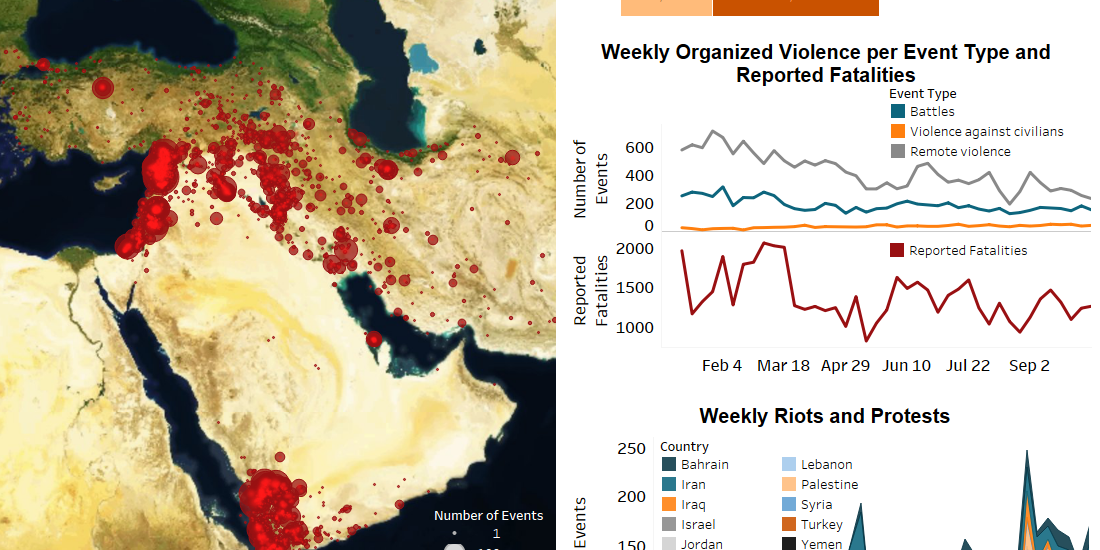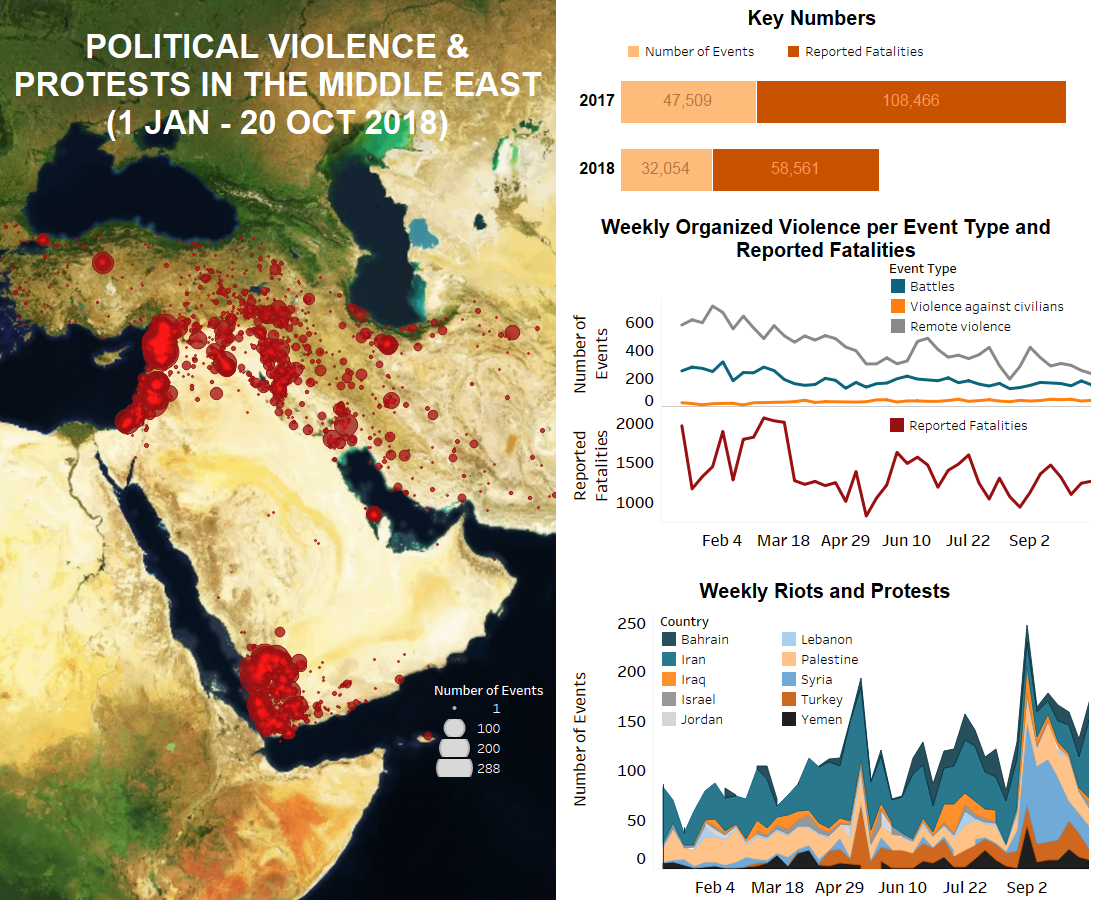Throughout the Middle East region last week, rates of political violence have remained relatively unchanged barring the renewal of cross-border violence in Gaza and southern Israel. In Iraq, Syria, and Yemen, battles and offensives remained generally concentrated in the same areas as the week prior. On the other hand, in Lebanon, a rare clash between armed groups in the Mieh Mieh Palestinian refugee camp may lead to further violence as the army attempts to assert control. In Jordan and Israel, long-closed crossings with Syria have been reopened to trade, while in Iran, nationwide labour demonstrations have continued and increased – a sign that the root economic causes remain unresolved.
In Israel/Palestine, cross border violence was renewed following the launching of two rockets from Gaza into southern Israel on October 17. One hit a home in Beersheba (40 km from Gaza) causing serious material damage and the other landed in the sea near Tel Aviv (70 km from Gaza). Both Hamas and Palestinian Islamic Jihad (PIJ) claimed that they did not launch the rockets and were adhering to the truce agreement being arranged by Egypt. However, Israel refuted this, saying that these groups are the only ones with the fire power to launch missiles of this range. Why these rockets were not intercepted by the Iron Dome remains a mystery. Israel responded to the rockets by conducting at least twenty airstrikes into Gaza, which reportedly killed one person and injured many. Supporting Hamas claims that they did not launch the rockets, Hamas representatives were reportedly actively discouraging people from approaching the border fence. This is the first time there have been reports of Hamas officials trying to quell the demonstrations (Arab News, 19 October 2018).
Meanwhile, in the West Bank, tensions continued to escalate between Palestinians and Israeli settlers as attacks on Palestinian olive groves and farmers increased dramatically. Additionally, there were a number of home demolitions by Israeli security forces.
In Lebanon, there was a major clash which reportedly killed two people in Mieh Mieh Palestinian refugee camp between Fatah (the party of the Palestinian Authority) and Ansar Allah (a pro-Hezbollah armed group). Mieh Mieh typically does not experience this kind of violence and Lebanese forces were brought in to help diffuse the situation. Security in Palestinian camps is maintained by the Joint Palestinian Security Force, and Lebanese Forces are generally prohibited from entering the camps. While the presence of Lebanese forces is meant to keep the situation under control, there is fear it may do the opposite (The Daily Star, 19 October 2018).
Last week in Jordan, the main crossing with Syria – Jaber crossing – was opened for the first time in three years. People in the area are hopeful that Jordanian trade and subsequently the Jordanian economy will improve due to lessened conflict in Syria (Daily Mail, 15 October 2018). Similarly, Israel recently opened the border crossing between Syria and the Golan Heights for the first time in four years.
In Iraq, IED attacks continued in large numbers throughout several governorates, particularly Diyala, Kirkuk, and Anbar. While these attacks cannot for sure be attributed to the Islamic State (IS), they generally fit with the post-war tactics of the group (for more on that, see this ACLED piece).
Elsewhere in Diyala governorate, it was reported that an IS commander known as Abu Dhoha was killed, alongside three of his companions, by Iraqi military forces during an ambush. It is being claimed that Dhoha was the mastermind of the Ahwaz military parade attack in Iran on September 22, 2018 (Mehr News, 16 October 2018).
Meanwhile in Iran, labour strikes and protests over unpaid salaries continued across the country last week. Noteworthy is the 2-day strike by teachers following a call by the Coordinating Council of Teachers Syndicates in Iran (CCTSI). Teachers in a dozen of Iranian provinces refrained from going to classrooms and staged sit-in protests in their schools. Pictures of their protests were shared over social media showing teachers raising banners and signs that expressed their demands for higher wages, the release of detained education activists, and an improvement to the quality of education (RFERL, 15 October 2018).
In Turkey, the killing of Saudi columnist Jamal Khashoggi in the Saudi consulate was made official last week. However, the Saudi narrative is different from the one being pushed by Turkish officials and attempts to distance the crown from the event. The Saudi report details the killing of Khashoggi as the result of a brawl following an attempt to take him back to Saudi Arabia. Turkey maintains that the journalist was kidnapped, tortured, and killed by Saudi personnel (Al Jazeera, 21 October 2018).
In Yemen, intense clashes continued last week between UAE/Coalition-backed forces and pro-Houthi militiamen in Hodeidah, with high fatality counts being reported around the Kilu 16 and Kilu 10 areas just outside the port city on the road to Sana’a. At the same time, pro-Hadi soldiers, backed by Saudi-led coalition airstrikes, continued to advance slowly into Sadah governorate, taking control of villages and mountain ranges in the districts of Kitaf and Baqim.
Meanwhile, four consecutive days of demonstrations turned violent as young Yemenis clashed with soldiers or were attacked as part of peaceful protests in Jardan district of Shabwah governorate. The demonstrators were demanding that they be recruited by the military forces of the Ataq axis – as had been previously agreed – to guard the pipeline area.
In Syria’s Deir-ez-Zor governorate, the fight against IS continued in two distinct areas. Around the Hajin enclave, Syrian Democratic Forces (QSD) forces, supported by Coalition warplanes and ground artillery, battled with IS fighters, reportedly killing dozens on October 20-21 in a tit for tat offensive that is now more than a month ongoing. Some smaller clashes were observed in the desert of Rural Damascus near Tlul al Safa between IS militants and soldiers from the regime, Hezbollah, and associated militias.
In northwest Syria, the Russian-Turkish agreed demilitarization zone continues to be generally respected by the majority of armed groups involved, many of whom were seen removing heavy equipment from the area the week prior. However, both Hurras al Deen and Ansar al Din Front have yet to withdraw their forces. In what may prove to be a future challenge, the ‘Wa Harredh al Moa’mineen’ Ops Room was established by Al Qaeda-affiliated groups refusing to honour the disengagement agreement (Twitter, 15 October 2018).
Elsewhere, regime forces engaged in shelling in and around Aleppo town, eastern Lattakia, southern Idleb, and northern Hama. Residents of dozens of towns across Idleb, Hama, and Aleppo governorates demonstrated after Friday prayers against the Assad regime and its Russian ally. About a month earlier, mass demonstrations occurred throughout these areas to demand an end to the regime offensive.







